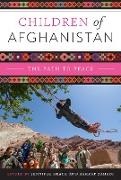Read more
The first comprehensive look at youth living in a country attempting to rebuild itself after three decades of civil conflict, Children of Afghanistan relies on the research and fieldwork of twenty-one experts to cover an incredible range of topics. Focusing on the full scope of childhood, from birth through young adulthood, this edited volume examines a myriad of issues: early childhood socialization in war and peace; education, literacy, vocational training, and apprenticeship; refugee life; mental and physical health, including disabilities and nutrition; children's songs, folktales, and art; sports and play; orphans; life on the streets; child labor and children as family breadwinners; child soldiers and militarization; sexual exploitation; growing up in prison; marriage; family violence; and other issues vital to understanding, empowerment, and transformation.Children of Afghanistan is the first volume that not only attempts to analyze the range of challenges facing Afghan children across class, gender, and region but also offers solutions to the problems they face. With nearly half of the population under the age of fifteen, the future of the country no doubt lies with its children. Those who seek peace for the region must find solutions to the host of crises that have led the United Nations to call Afghanistan "the worst place on earth to be born." The authors of Children of Afghanistan provide child-centered solutions to rebuilding the country's cultural, social, and economic institutions.
List of contents
Acknowledgments Introduction Jennifer Heath Part I. The Way We Were; The Way We're Seen Chapter 1. Before the Wars: Memories of Childhood in the Pre- Soviet Era Amina Kator-Mubarez Chapter 2. Narratives of Afghan Childhood: Risk, Resilience, and the Experiences that Shape the Development of Afghanistan as a People and a Nation Anne E. Brodsky Chapter 3. Jumping Rope in Prison: The Representation of Afghan Children in Film Teresa Cutler-Broyles Part II. Ties That Bind: The Family in Rebound Chapter 4. Love, Fear, and Discipline in Afghan Families Deborah J. Smith Chapter 5. Children Who Live with Their Mothers in Prison Esther Hyneman Chapter 6. Little Brides and Bridegrooms: Systemic Failure, Cultural Response Sharifa Sharif Part III. Survival by Any Means Possible Chapter 7. Confronting Child Labor Amanda Sim Chapter 8. The Parakeet Boys: Performing Education in the Streets of Kabul Wahid Omar Chapter 9. Child Soldiering in Afghanistan Delphine Boutin Chapter 10. Legal Protection: Offering Aid and Comfort Hangama Anwari Part IV. To Be Whole in Mind and Body Chapter 11. Children's Health: The Challenge of Survival Steven Solter Chapter 12. Food Security and Nutrition for Afghan Children Fitsum Assefa, Annalies Borrel, and Charlotte Dufour Chapter 13. Desperately Seeking Harun: Children with Disabilities Lael Adams Mohib Chapter 14. "Life Feeds on Hope": Family Mental Health, Culture, and Resilience Mark Eggerman and Catherine Panter-Brick Part V. Education: Nurturing the Future Chapter 15. Education in Transition: A Key Concern for Young Afghan Returnees Mamiko Saito Chapter 16. Primary and Secondary Education: Exponential Growth and Prospects for the Future Omar Qargha Chapter 17. Music and Literacy: A New Approach to Education Louise M. Pascale Part VI. Communicating Empowerment Chapter 18. "Thanks God for the Twitter and the Facebook! Thanks God for That!" Lauryn Oates Chapter 19. The New Storytellers of Afghanistan Joanna Sherman Chapter 20. Six Epiphanies: Testament to Change from Inside an Afghan Orphanage Ian Pounds Epilogue: Imagining the Future Ashraf Zahedi Selected Bibliography and Filmography About the Contributors Index
Summary
A sweeping examination of Afghanistan’s most vulnerable individuals and the myriad of problems that confront them, Children of Afghanistan not only explores the host of crises that has led the United Nations to call the country “the worst place on earth t

